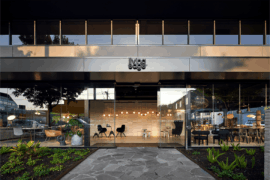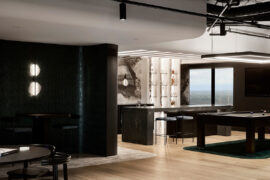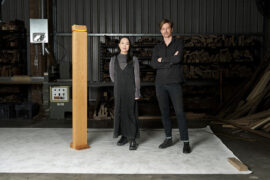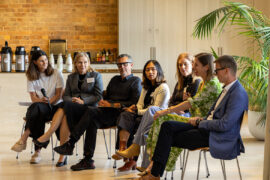Simple materials + clever layout overhaul = an incredibly hip New York-inspired deli.

The tight L-shaped space on Hong Kong’s hip Star Street used to house an L-shaped izakaya-type joint, and before that, an L-shaped pizza place. Now it is home to Morty’s Delicatessen – a fetching sports bar and deli specialising New York City fare. Clad in red tiles, Morty’s entices passersby with a bold street-facing kitchen window.
Morty’s is the latest in a series of collaborations between fashion designer entrepreneur Kevin Poon and interior design studio JJA / Bespoke Architecture, helmed by designer JJ Acuna. Both entrepreneur and designer were educated in the US and for this project, they drew inspiration from Manhattan’s local pubs and diners.
“The client had a tight budget and we had a very small space to work with. What’s more, it had two entry points, front and back,” says Acuna. He altered the original layout of the space to make it more breathable.
“We got rid of the L because it was just too awkward and instead made a rectangular bar-restaurant and moved the back of house kitchen front of house – where the short part of the L is. We give each programme, the front and the back-of-the-house, its own room to breathe,” he explains.
“Moving the kitchen to the front has made the the whole food preparation process a kind of theatre where passersby can appreciate and observe all that goes on in the process of creating a meal,” he adds. This design decision also effectively makes use of the back and front alleys. Crowds can spill out into both areas when it’s busy, creating a jovial and relaxed indoor-outdoor eating and drinking environment.
Working with the modest budget, the design team combined simple tile finishes and stainless steel surfaces to a great effect – the red gloss of the tiles catches one’s attention while the mirror effect of the stainless steel gives the linear ‘dining cabin’ an additional sense of levity. Everything in the project was created bespoke for the site, except the aluminium Prouve Chairs.
Asked if ‘theme’ is a dirty word in design, Acuna says: “I think the word ‘theme’ is dirty when the set-up is a literal cut and paste. I think our iteration of the concept is a remix or a play on a thematic concept.” He elaborates that in Morty’s case the interior takes a back seat to the customer’s experience.
He adds, “In the Hong Kong context, we hope it’s a greatly comfortable and casual urban atmosphere for all kinds of people to visit and enjoy a meat-filled meal and a sports event on the television – which is really the goal here, to create a no-frills, low-maintenance destination for people to enjoy simple food and beers with friends.”
Photography by Natasza Minasiewcz
INDESIGN is on instagram
Follow @indesignlive
A searchable and comprehensive guide for specifying leading products and their suppliers
Keep up to date with the latest and greatest from our industry BFF's!

For Aidan Mawhinney, the secret ingredient to Living Edge’s success “comes down to people, product and place.” As the brand celebrates a significant 25-year milestone, it’s that commitment to authentic, sustainable design – and the people behind it all – that continues to anchor its legacy.

A longstanding partnership turns a historic city into a hub for emerging talent

London-based design duo Raw Edges have joined forces with Established & Sons and Tongue & Groove to introduce Wall to Wall – a hand-stained, “living collection” that transforms parquet flooring into a canvas of colour, pattern, and possibility.

The shared Melbourne office brings together Studio 103 and McCormack in a dual headquarter that doubles as a showcase of materials and craft.

AHEC’s KEEP exhibition at Cult Sydney sees six Australian architects craft lasting furniture pieces, on view until 4th October.
The internet never sleeps! Here's the stuff you might have missed

In this comment piece by Dr Matthias Irger – Head of Sustainability at COX Architecture – he argues for an approach to design that prioritises retrofitting, renovation and reuse.

We think of the chair as a ubiquitous object but every now and then there is a design that ticks all the boxes and makes its presence felt on the global stage.